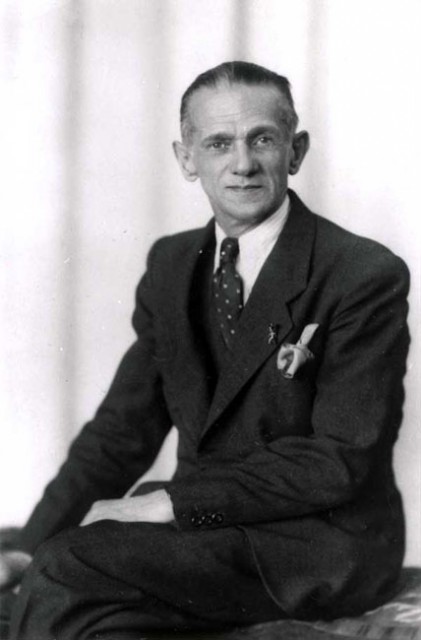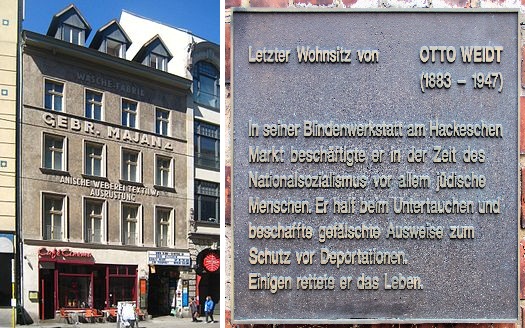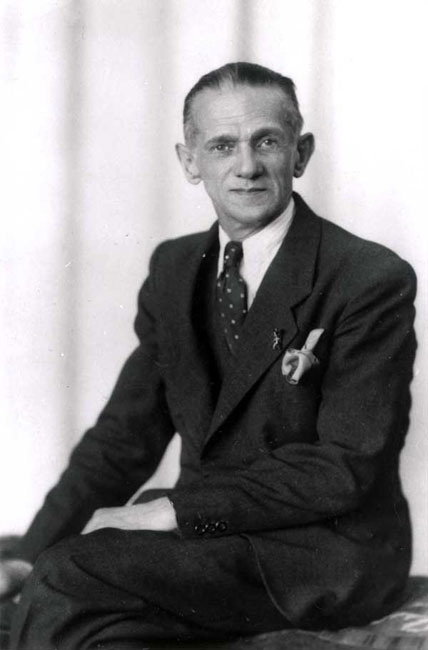
Otto Weidt was so much like Oskar Schindler – he was a German factory owner who used his business to save Jews. But unlike Schindler, he was blind and unrecognized until now.
Summer of 1944 – A postcard flapped onto the railway tracks between Auschwitz and Theresienstadt concentration camps. It had been slipped through one of the cracks of the cattle wagons’ floorboards. These crummy airless boxes had borne Jews from around Europe on their way to the gas chambers.
The postcard was 23-year-old Alice Licht’s last attempt at surviving the Holocaust. She was aboard the “death train” along with her family. In what could have been a miraculous streak, her postcard was posted to the factory it was addressed to – a brush factory in Berlin owned by a certain Otto Weidt.
Weidt was Alice’s German employer and upon getting her postcard a few days later, he immediately went off to Auschwitz in search for her to try to save her and her family from their impending death in the camp. However, when he got there, Alice had been moved to another prison house while her family was murdered in the gas chambers.
But this did not stop Otto in his effort to save the young lady and when he was able to get hold of her even when she was still being held by the Nazis. He then spruced up a safe house near the camp she was in in preparation for her escape. The chance presented itself a few months later after she was sent off to Auschwitz, in January 1945. By this time, Soviet’s Red Army was strongly advancing against the Nazis and the latter started evacuating their camps throughout Eastern Europe.
Alice managed to slip away from the Nazis in one of their “death marches” and went to the safe house Weidt arranged. She then found her way to Berlin and eventually to her former employer. he kept her hidden until the Nazis defeat in May 1945.
Miss Licht was just one of the many Jews Otto Weidt helped to escape the Holocaust. In Germany, he is being set side by side with his more well-known contemporary, Oskar Schindler, whose life was immortalized in Steven Spielberg’s WWII movie Schindler’s List.
Both men saved many Jews from the Holocaust. But Otto Weidt’s tale has this one amazing touch – he did it all though he was blind.

Last Sunday, Germany’s ARD Television Channel honored this relatively blind “unknown Schindler” for the first time with a film of his own, The Blind Hero.
The Blind Hero was based almost exclusively from the memoirs of Inge Deutschkron, the 92-year-old German-Jewish writer and one of the Jews Weidt saved from the Holocaust. Initially, he employed her then later on, he hid her and her mother in clandestine Berlin addresses until the end of WWII. The acclaimed I Wore the Yellow Star was her story about how she survived in Nazi Berlin.
Otto Weidt was well in his 50s when he started his Berlin brush factory to seemingly help the war efforts of the Nazis and is played in the movie by actor Edgar Selge.
“The most important thing was that he was taught how to move like a blind person as preparation for the part,” Mrs Deutschkron said in an interview before the film’s screening.
The Blind Hero also shows how different Weidt was to Schindler. While Oskar had started his business first and his saving the Jews from the Holocaust had looked like it was a sideline to his running it, Weidt had been an original anarchist, was zealous in his being anti-Nazi and had detested Hitler even from the start. His factory had been put up to save Jews, many of whom were blind, by employing them.
Inge Deutschkron recounted how Weidt used his skills as a liar and a clever conman to outfox the Nazis. Deutschkron had been one of the few fully sighted employees he had in his factory; she worked as a telephone receptionist from 1941 onwards.
Her employer had to deliver all his products to the Wehrmacht war machine but this he did not do. As Mrs. Deutschkron explained, horsehair brushes were rated as first-class wedding presents so Weidt chose to market his produce elsewhere, meaning he sold them off on the black market to Karstadt, a German department store chain.
The money he gained from his illegal sales he used to buy luxury goods which he then used to bribe the Gestapo so that they would leave his Jewish employees and factory alone. These luxury goods included crates of champagne, boxes of first-rate cigars and even expensive scents which he said were “for the dear lady”. Weidt dutifully supplied Hitler’s men with these things and they left him, his factory and employees untouched and unharmed.
“The film cannot recreate the fear that we felt but it also cannot bring back the joy we experienced after Otto managed to save the lives of his staff with his ‘perfume for the lady’,” Inge Detuschkron said.
When 1943 came, the Nazis decided to make Berlin totally Judenrein or Jew-free so Weidt was forced to look for places where his employees could go hide until the war’s end though not all of them escaped death. Inge Detuschkron with her mother moved from one hiding place to another to escape the Nazis.
The next year, the postcard from Miss Licht came and Otto Weidt, who was in love with her in spite of their age difference, gambled his life and traveled to Auschwitz just to save her.
In the end, he triumphed and Miss Licht came to him safe in Berlin. He managed to hide her until the war ended three months later. However, Miss Licht did not stay with him for good after May 1945. She migrated to America not long after never to be seen or heard again. Otto Weidt died two years later, in 1947. Years following his death, Otto Weidt was recognized for his war efforts in helping the Jews when he was given the honor of being “Righteous among the World’s Nations” at Israel’s Yad Vashem memorial.

Inge Deutschkron pointed out that saving Jews like her had put so much strain on Weidt. In 1993, she had a memorial plaque to commemorate his feats installed in the site of his former Berlin factory.
